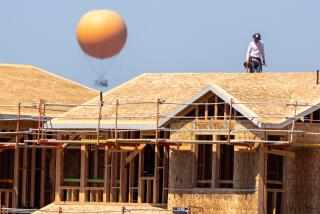Covina’s New Brand of Tax Rebellion Is Capturing Statewide Interest
- Share via
Taxes are more than an inevitability in Covina. They’re an obsession.
Voters in this San Gabriel Valley community sacked the entire City Council a few years back as punishment for the panel’s approval of a 6% utility users tax. The new council then passed an even larger tax, sparking a fresh outburst of recall fever until voters finally ratified the tax at the polls.
Now there is a fresh tax rebellion brewing in Covina--this time launched from inside City Hall. City officials, enlightened by the utility tax wars and seeking new sources of money, are at the forefront of a statewide crusade by municipalities to improve finances by capturing a larger share of the state sales tax.
“I don’t think we’re referred to as the recall city anymore,” said City Manager Francis M. Delach, who came up with the sales tax proposal and has spearheaded the drive. “We’re referred to as the tax rebellion [city].”
The Covina proposal would steer an additional 1% of the state’s 7.25% sales tax to cities whose residents vote to receive a bigger chunk of sales tax proceeds. That extra money would go into a shared pot and then be divided among those participating cities according to population. Now, 1% of the state sales tax goes to the city where the sale is made.
*
The proposed change faces long odds because of the state’s reluctance to give back money. The bill’s sponsor in the state Senate put the measure on hold in April when support on a key committee appeared weak. Focus is now on a rival proposal that would aid municipalities by returning property taxes the state took in order to meet its obligations to public schools during the recession of 1992-94.
But Covina’s sales tax push has raised the profile of the community of 45,000.
The so-called “Covina bill” last year won a majority vote in the state Assembly but fell short of the two-thirds needed for passage. Covina officials launched a widespread campaign, bombarding city halls around the state by fax, and won endorsements from nearly 300 cities and several groups representing local governments. This time around, cities have kicked in about $12,000 to cover the costs of Covina’s lobbying work.
*
Delach said the two-year effort was inspired by a feeling shared by anxious city officials and fed-up residents alike: that too little of taxpayers’ money makes its way back to cities for local services. In that regard, the Covina campaign is a cousin of previous ballot measures championed by anti-tax crusaders to increase local control over taxes. The Howard Jarvis Taxpayers Assn. has lent its support to the campaign.
“Why did citizens vote in Proposition 13? Why did they vote in [Proposition] 62? Why did they vote in 218?” Delach said, citing several tax-cutting measures. “There is a lack of trust and a feeling among taxpayers that they’re getting the short end of the stick.”
Supporters say the sales tax shift could be accomplished without raising the rate or cutting state programs. The $4 billion that would be moved to cities--phased in over five years--could come from growth in state revenues, said Cary Kalscheuer, a Covina staffer.
In Covina, the gain from an extra percentage point from the sales tax would amount to about $4 million--roughly the sum now produced by the city’s 7% utility tax.
Backers say the scheme would reduce the often expensive competition among cities for businesses, such as car dealers, which create lots of local sales tax earnings.
“It helps solve all the fighting among cities for sales-tax generators,” said David Smith, management consultant for the 49-member Independent Cities Assn.
But foes contend that the state cannot afford to shift that amount of sales tax earnings to the cities without risking a raid on county treasuries.
“It punches a big hole in the state budget,” said Daniel J. Wall, deputy director of the California State Assn. of Counties, which has opposed the measure. The counties, joined by business and real estate interests, favor a longshot bill to help localities by handing back property taxes.
“The smart course of action here is for Covina and the cities to buckle down and try to get the property issue settled this year,” Wall said.
Smith said the answer may be a mix of the two approaches--returning some property taxes to cities and counties while awarding communities a larger slice of the sales tax.
Covina officials have one more trick up their sleeves: the voters. In a letter faxed to municipal officials statewide last week, Mayor Thomas M. O’Leary suggested waging the fight by ballot measure.
“We are not done yet,” he said.
More to Read
Sign up for Essential California
The most important California stories and recommendations in your inbox every morning.
You may occasionally receive promotional content from the Los Angeles Times.










